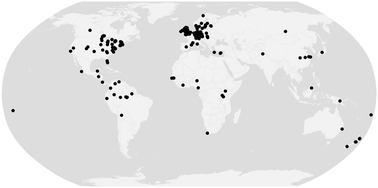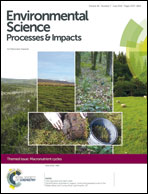Atmospheric deposition of phosphorus to land and freshwater†
Abstract
We compiled published and newly-obtained data on the directly-measured atmospheric deposition of total phosphorus (TP), filtered total phosphorus (FTP), and inorganic phosphorus (PO4-P) to open land, lakes, and marine coasts. The resulting global data base includes data for c. 250 sites, covering the period 1954 to 2012. Most (82%) of the measurement locations are in Europe and North America, with 44 in Africa, Asia, Oceania, and South-Central America. The deposition rates are log-normally distributed, and for the whole data set the geometric mean deposition rates are 0.027, 0.019 and 0.14 g m−2 a−1 for TP, FTP and PO4–P respectively. At smaller scales there is little systematic spatial variation, except for high deposition rates at some sites in Germany, likely due to local agricultural sources. In cases for which PO4–P was determined as well as one of the other forms of P, strong parallels between logarithmic values were found. Based on the directly-measured deposition rates to land, and published estimates of P deposition to the oceans, we estimate a total annual transfer of P to and from the atmosphere of 3.7 Tg. However, much of the phosphorus in larger particles (principally primary biological aerosol particles) is probably redeposited near to its origin, so that long-range transport, important for tropical forests, large areas of peatland and the oceans, mainly involves fine dust from deserts and soils, as described by the simulations of Mahowald et al. (Global Biogeochemical Cycles 22, GB4026, 2008). We suggest that local release to the atmosphere and subsequent deposition bring about a pseudo-diffusive redistribution of P in the landscape, with P-poor ecosystems, for example ombrotrophic peatlands and oligotrophic lakes, gaining at the expense of P-rich ones. Simple calculations suggest that atmospheric transport could bring about significant local redistribution of P among terrestrial ecosystems. Although most atmospherically transported P is natural in origin, local transfers from fertilised farmland to P-poor ecosystems may be significant, and this requires further research.

- This article is part of the themed collection: Macronutrient Cycles

 Please wait while we load your content...
Please wait while we load your content...